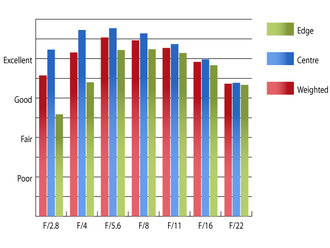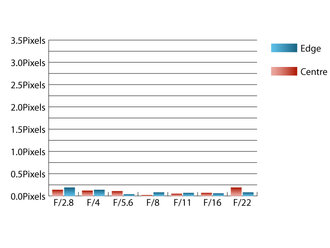Samyang 14mm f/2.8 ED AS IF UMC Lens Review
Samyang 14mm f/2.8 ED AS IF UMC Performance
You may be forgiven for expecting poor optical performance for such an inexpensive lens, but that certainly isn't the case with the Samyang 14mm. Sharpness in the centre of the image area is already excellent at f/2.8, although the quality towards the edges of the frame falls behind somewhat.Stopping the lens down improves quality across the frame, reaching excellent levels between f/5.6 and f/11. This would be very good performance for any lens, but this is quite incredible for such an inexpensive optic.
 Resolution at 14mm | How to read our chartsThe blue column represents readings from the centre of the picture frame at the various apertures and the green is from the edges. Averaging them out gives the red weighted column.The scale on the left side is an indication of actual image resolution. The taller the column, the better the lens performance. Simple. For this review, the lens was tested on a Nikon D700 using Imatest. |
Chromatic aberrations barely register across the frame at any aperture, which is superb for such a wide lens. No issues should be seen, even in very large prints.
 Chromatic aberration at 14mm | How to read our chartsChromatic aberration is the lens' inability to focus on the sensor or film all colours of visible light at the same point. Severe chromatic aberration gives a noticeable fringing or a halo effect around sharp edges within the picture. It can be cured in software.Apochromatic lenses have special lens elements (aspheric, extra-low dispersion etc) to minimize the problem, hence they usually cost more. For this review, the lens was tested on a Nikon D700 using Imatest. |
Falloff of illumination towards the corners is quite severe. At f/2.8 the corners are 3.4 stops darker than the image centre and visually uniform illumination isn't achieved until the lens is stopped down to around f/11. Such a high level of vignetting can lead to exposure errors, as pictures taken at maximum aperture require a little more exposure to appear as bright as pictures taken stopped down. This can lead to overexposure when using small apertures.
Imatest detected 4.56% barrel distortion, which is quite strong, but the whole story. Images display quite a pronounced 'M' shaped wave to the distortion, which will prove incredibly difficult to correct in image editing software afterwards.
Contrast is lacking from the off, when this lens is compared to manufacturer's own lenses. Still this lens deals reasonably well with harsh light sources in the frame, especially when stopped down beyond f/5.6.
Add your message
Login required
Please login here or if you've not registered, you can register here. Registering is safe, quick and free.
Please login here or if you've not registered, you can register here. Registering is safe, quick and free.
photodo Stats
1102 lenses
428 MTF tests
74 in-depth photodo reviews
100+ users join each day
Help the lens community by reviewing or rating a lens today via our lens search
428 MTF tests
74 in-depth photodo reviews
100+ users join each day
Help the lens community by reviewing or rating a lens today via our lens search
Latest Lens Reviews
- Chinon 28mm f/2.8 Vintage Lens Review
- Canon EF 70-200mm f/4L IS II USM Lens Review
- Samyang AF 85mm f/1.4 EF Review
- Sigma 70mm f/2.8 DG Macro Art Review
- Samyang AF 24mm f/2.8 FE Review
- Meike 50mm f/1.7 Review
- Tamron 70-210mm f/4 Di VC USD Review
- Lensbaby Burnside 35mm f/2.8 Review
- Asahi Super Takumar 50mm f/1.4 Review
- Asahi Super-Multi-Coated Takumar 135mm f/3.5 Review
